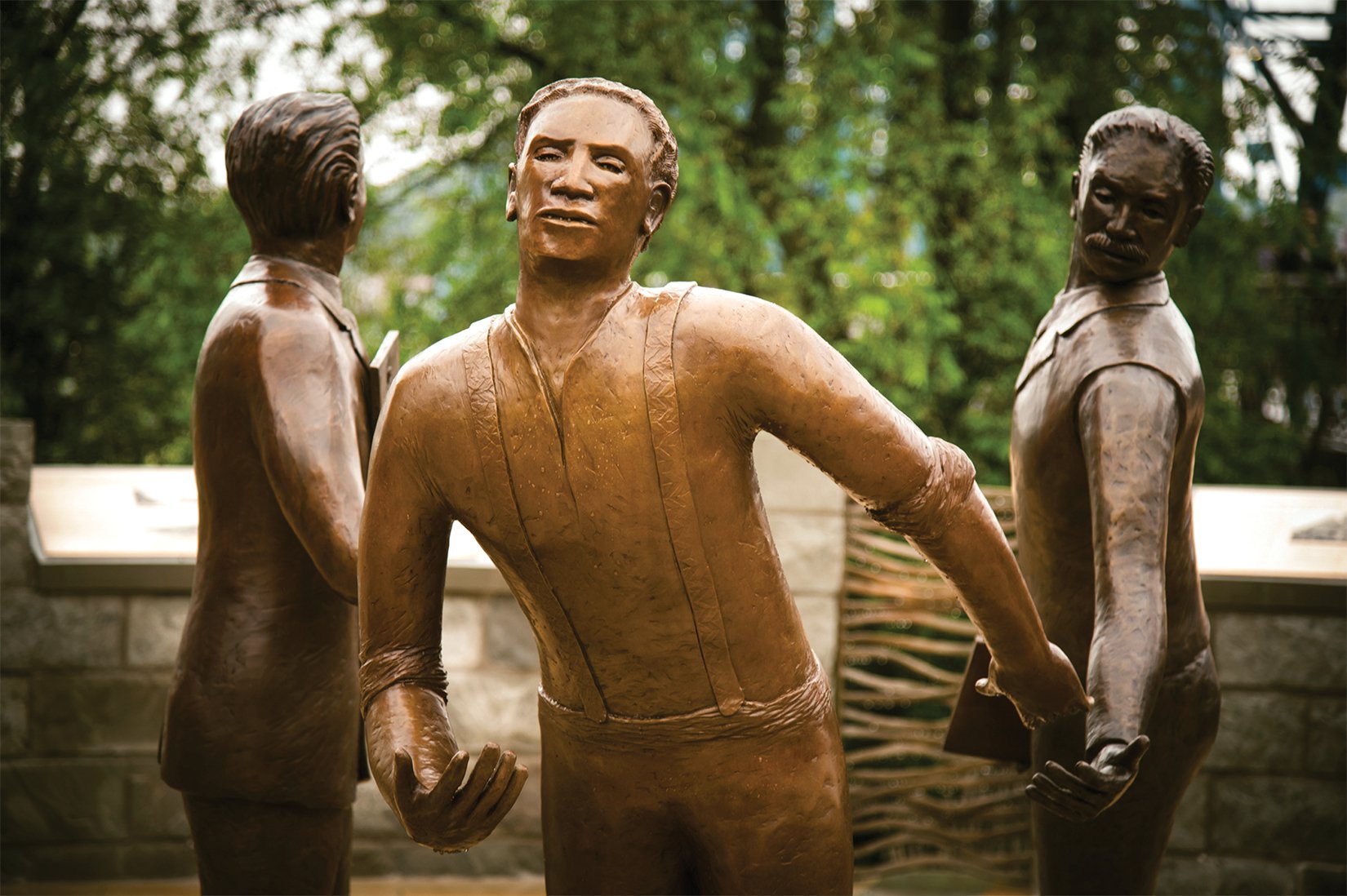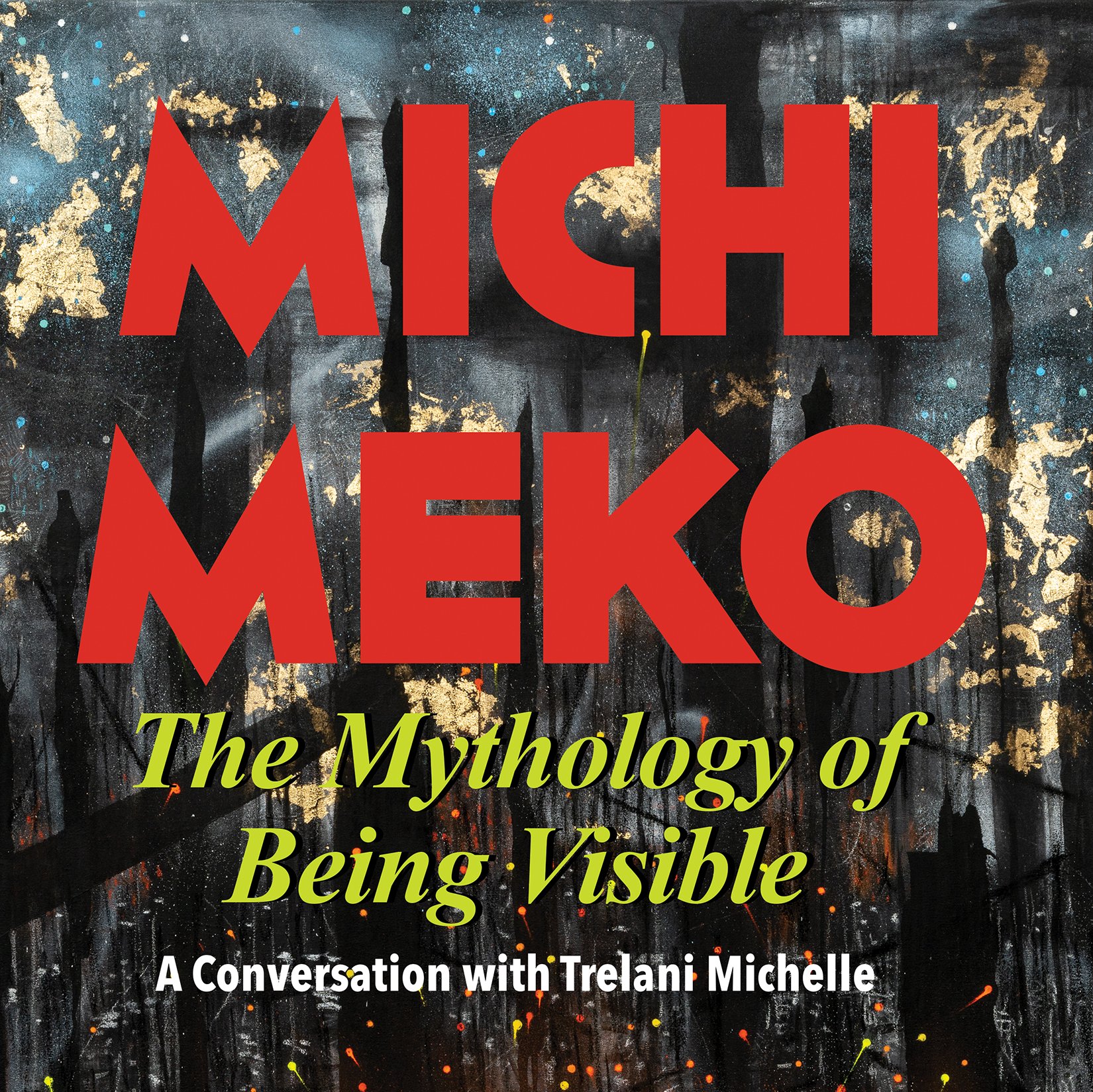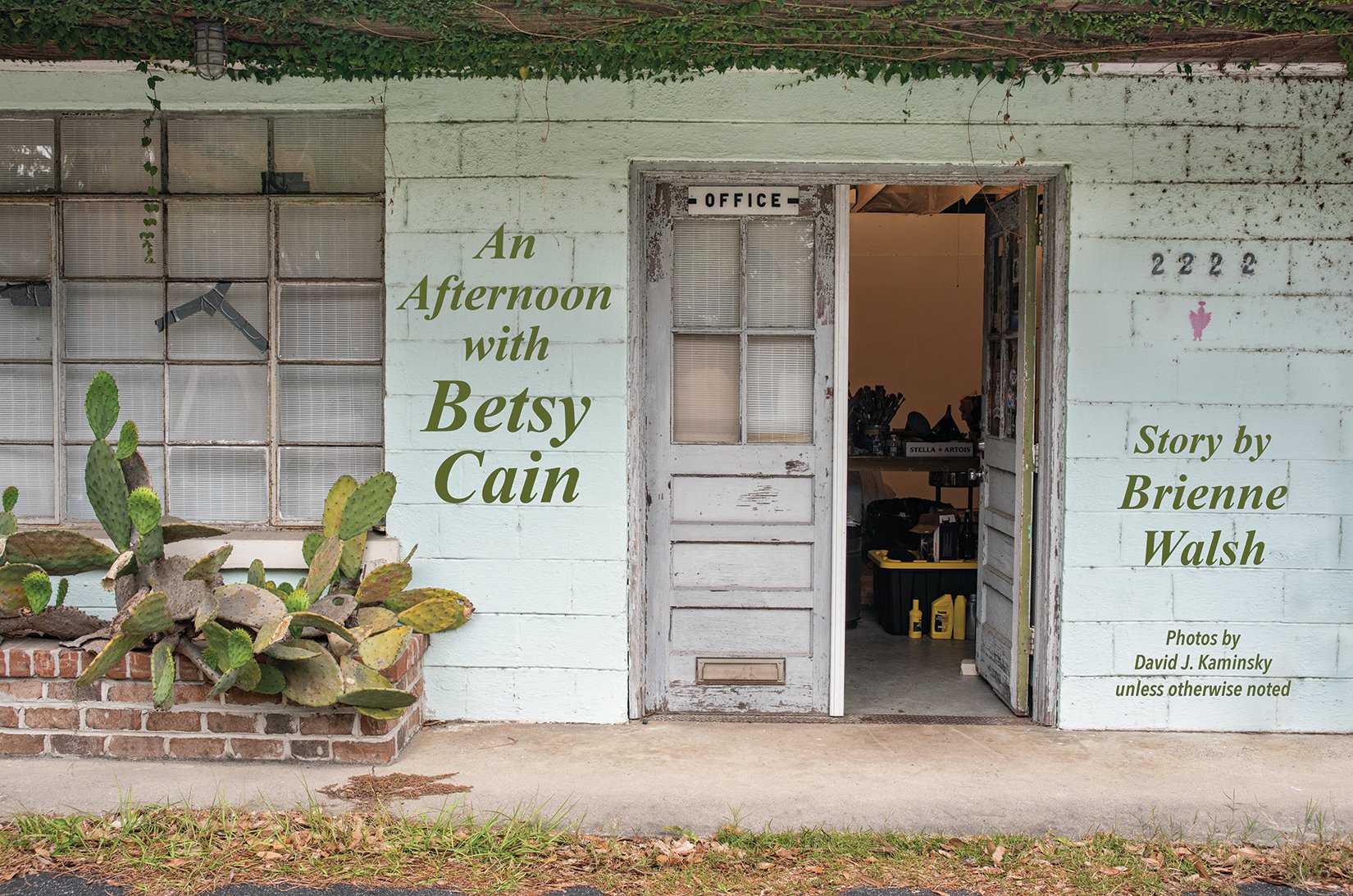For the past 25 years, Jerome Meadows has been a staple of Savannah’s art scene. Hailing from New York City, Jerome first came to Savannah in 1997 to work on a public art installation for Yamacraw Art Park (much more on that later). His notable public art installations include the African Burying Ground Memorial in Portsmouth, New Hampshire (2013) and the Ed Johnson Memorial in Chattanooga, Tennessee (2021) – both of which called on the artist to honor and unpack a community’s history of racial violence.
Most recently, Jerome unveiled an installation at Savannah’s own Enmarket Arena titled “Of Communities and the Land and the Trees that Bear Witness to Them.” In addition to his public art installations, I’ve also seen his collage work and smaller sculptures in galleries all around town, and read about his passion for revitalizing Waters Avenue corridor, a majority Black neighborhood on Savannah’s east side and the location of Jerome’s studio. The studio – a 7,000 square-foot former ice factory – was easy to spot, and I arrived excited to interview the artist I’d heard so much about and see the place where he creates.
Meadows in his Waters Avenue studio, 2023. Photo by Emily Earl
Jerome greeted me near a purple set of double doors and welcomed me inside, shutting the warm Savannah air behind us. The front room looks like his work space featuring a few completed works of assemblages covering the walls. To the left is Indigo Sky Community Gallery, a cultural gathering place for art and performance that Jerome owned and operated from 2004 to 2018. I find the real treasure, however, after he leads me down a slim set of metal stairs.
This room is cavernous. Light comes in through several high placed windows and the vines of a tree have made their way inside. He had an industrial crane installed to help him lift heavier pieces; and the hook hangs from the ceiling to rest chest level in the center of the room. Large pieces of art – some finished, some in the midst of being repaired – are littered about. Two beams of iron are bent into a semicircle by chains and held in place by the weight of a large stone. Jerome places a hand on it and pushes it gently, making it rock back and forth. I see more stone figures than I can count. The space is still a factory of sorts, though today, it manufactures art instead of ice.
In this interview, Jerome talks about discovering himself as an artist during the civil rights movement, partnering with communities on public art installations, and how he feels called to create work outside of the ivory tower of galleries and museums. We talked about his frustration with the Yamacraw art project, and I learned about his love/hate relationship with what he calls the city of “Slow-vannah.”
Ariel Felton: Let’s start at the beginning. Do you recall what first called you to create?
Jerome Meadows: My first recollection of doing art is kind of a paradox. I'm living in the Bronx, New York City, on the sixth floor of a tenement. It was a rather cavernous kind of environment. I'm about five or six years old, sitting at the dining table, hearing the train go by every 15 minutes, and drawing horses. [laughs]
There's no horses around and I'm like, obsessed with horses. I've got them talking to each other. I got them running across the plains, and they're fairly representational. It wasn't until later that I realized – wow, this is the power of art, to enable you to divorce yourself from a situation or space that you don't feel connected with.
I also became infatuated with Michelangelo. I was really impressed by what's referred to as his slave series. It's these massive blocks of stone, and his style is very muscular and anatomically correct. These figures seem to be struggling to get out of that block of stone. His philosophy, his objective as an artist, and as a sculptor in particular, is to look at the block of stone and see that figure inside of it, and his job is to release it. But conceptually, that resonated with me in terms of New York City. The sense that it's a struggle to be who you are. All of this was adding up to me as a youngster in this city and realizing it’s not really where I feel at home.
AF: I read an interview where you said that Rhode Island School of Design is “where race and art came together” for you. Could you tell me more about that experience of formalizing an art practice that you discovered so naturally?
Sculptures in Meadows’ studio, photo by Emily Earl
JM: At RISD, there was such a small number of minority students; and when I say minority, not just Black, but Native American, Asian. RISD had been remiss in their diversity. Prior to us coming in there it was 1%. So the federal government said, ‘look, to the extent that you're expecting federal funds, you need to boost this up.’ This was during the ‘60s Civil Rights Movement, so we’re hearing this phrase a lot: ‘if you're not part of the solution, you're part of the problem.’ So we were more inclined to look at other artists who were fighting the cause. Baldwin was a major hero. We're students, yes, and we're developing ourselves as artists, but at the same time always hearing ‘if you're not part of the solution, you're part of the problem.’ It was a time for civil unrest and correction, but it's in the context of an art school and developing as an artist.
AF: You seem particularly drawn to public art. Why is that?
JM: If I spoke to 10 gallerists in a week, nine of them were assholes. And this stood in stark contrast to public art projects. If there were 10 people [working on a project], only one of them was an asshole, and he would be thrown out of the room. [laughs]
The other benefits, of course, are working large, being paid a significant amount of money and then the finished piece is placed outside in a public setting, which is the opposite of the ivory tower, where your work goes into some place and only a handful of people see it. I kept going back to that statement: the solution vs. the problem. Here's how I can make a difference with respect to my work speaking to the public, and all the public art projects I’ve done have all been along those lines.
AF: Was there a moment early in your career that you felt ‘wow, I’ve made it. I’m the artist I want to be’?
JM: Oh, sure, but it was a roller coaster ride to get there. This may sound silly, but I used to get up and go out to be involved in rush hour traffic, because I wanted to remind myself of what it is that I have been able to avoid – working a 9 to 5. Part of me kept thinking at some point the floor's gonna go out on the ‘being a full-time artist’ thing. But the mantra that I have is ‘Money follows passion.’ If you want to be an artist, that's your calling. Be passionate about it, and the money will come. The tricky part of that, I equate it to standing on a cliff. And the opportunity you're looking for is up there. It takes wings to get up there. But the irony of the situation is you have to take the leap for your wings to come out. That’s the only way you’re going to get up there.
AF: That’s quite a leap of faith!
JM: [laughs] Yes, but I'd rather risk the splatter!
AF: What if the wings don't come out?
JM: Well, the thing about wings is they only come out when they're needed. They're not just for show, or to prove something to somebody. They come out when they're needed. Those philosophies and assistance from the ancestors have made it possible for me, for decades now, to be a self employed artist living in his 7,000 square foot studio. Every morning, I decide what I'm going to do. I’m really proud of that.
Primary Circle, Ed Johnson Memorial, Chattanooga, Tennessee. Photo courtesy of the artist.
AF: Let’s talk about the African Burying Ground in Portsmouth, New Hampshire. In 2003, construction workers discovered the remains of eight individuals determined to be of African descent, shocking the community and motivating them to honor this uncovered history. Can you tell me how you honored the community’s wishes and still brought in your own style and voice?
JM: It’s a matter of trying to open myself up to the story. One of the good things was that the people of Portsmouth - and I should point out [Portsmouth] is 92% white - instead of them saying, ‘oh, this is fake news, down with Africana Studies,’ and all of that nonsense, [laughs] they said ‘wow, this is a part of our history. We need to do something about it.’ They raised $1.2 million in a relatively short amount of time, and this is the kind of openness that I was dealing with when I would talk to people about the story and the project.
The piece is about the first enslaved African man brought into Portsmouth in 1645. The formal entry has a granite wall. It's about eight feet tall, four feet wide and nine inches thick. On one side of that wall, standing on the edge, is a male figure. He's looking down into the memorial, and his hand is around the edge of that granite wall. On the opposite side is a female figure. He represents that first slave coming in. She's representing Mother Africa and she's reaching around the same side. I created these here in the studio and I'm struggling with whether or not the hands should touch, so I took it to the committee. They surprised the hell out of me! They said ‘oh, they should not be touching by about an inch.’
That's the degree of connection that public art affords me. I don't know if every artist has that. Because the committee is saying, we know what we want by way of concept, but if we could do it as artists, then we wouldn't need you. So we need you to come in and take that concept and give it meaning, give it expression. That was a perfect example of how that teamsmanship works.
Portsmouth African Burying Ground Memorial Park, with flowers. Portsmouth, New Hampshire. Photo courtesy of the artist.
AF: How would you say your style has changed over the years?
JM: I’ve learned that bigness isn't my thing. Rather than going 30 feet tall, I prefer to go 30 feet horizontal. Rather than something that's big, that you crane your neck to look at and it feels off-putting and separated, particularly with Martin Luther King and people who are about the people. When it comes to sculptures of individuals, psychological and emotional connection is stronger when you're on eye level with that person or that character. That’s a stylistic thing that I didn't necessarily start out intentionally doing, but it just seemed to be the logical way of approaching public art.
AF: What did you expect to find here in Savannah’s art community and did it live up to your expectation?
JM: I had no idea of what to expect, but I was not expecting Slow-vannah. I was misled because in that first meeting about the [Yamacraw art] project, everybody was there: the city manager, the mayor, and council members. I remember distinctly that we couldn't start until a certain individual gave his approval, and that was W.W. Law. Literally we sat there for about 45 minutes waiting, but fortunately, he called in and gave it his blessing. That should have told me something, the fact that it took that long. But I was compelled by the fact that the ocean is 20 minutes away, this building was what I needed, and then a handful of friends who already lived here. It’s been a love/hate relationship to be perfectly honest with you.
Portsmouth African Burying Ground Memorial Park. Portsmouth, New Hampshire. Photo courtesy of the artist.
AF: The Yamacraw Art Park project that brought you here was vandalized, then allowed to fall into disrepair for about 20 years. How does it feel to have it finally restored and the art park renamed as an official square? I imagine that was another roller coaster!
JM: Well, let me qualify that roller coaster was one in slow motion. [laughs] At this point, I've pretty much gotten over the anger and frustration that [the piece] was allowed to be neglected and in many ways, I'm seeing it new. For example, those plaques were always supposed to be bronze, but [due to the budget, they were] turned into aluminum. So the aesthetic wasn't there and they were very easily vandalized. So now finally I've seen the bronze panels, the banner supports and everything is clean.
I'm quite honored to be a living current day designer of a Savannah square. I would hope that this project and the new square will provide some positivity. It does in terms of children. The reason why there's three children dancing in that fountain is pretty much every time I would go over there and sit just to kind of feel out the space, these children would show up. And it was interesting because right after the dedication, there were children playing in the fountain. So for a community, the children are our future.
###











